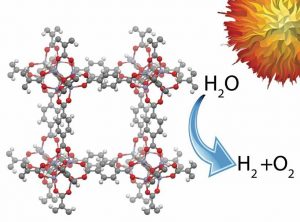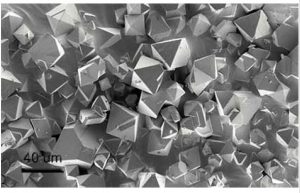A New Family of Materials For The Energy And Environment
Por la Dra. Manuela Leticia Kim y el Dr. Eugenio Hernán Otal (División Materiales Porosos, UNIDEF, CITEDEF-CONICET)
The current state of the energy matrix requires short-term changes. The first steps taken by Argentina in the area of renewable energy were through the decree 9/2017 which has declared this year as the “year of renewable energy” and of the plan RENEW. Both actions are most appealing to the science and technology of our country. Taking into account the needs of the society, the community of scientists and technology Experts have been working on this area for decades in the hope of achieving tangibles results for the society . On the basis of these assumptions, the Division of Porous Materials of the UNIDEFCITEDEF- CONICET made up by the Dr. Eugenio Otal and the Sr. Manuela Kim focused on studying how the science of materials can be at the service of energy and environment in a practical, sustainable and economically feasible way. I n this context,we have been working in a new family of hybrid polimors called Metal Organic Framework or MOFs since 2012. These materials were developed by Omar Yaghi and his co-workers in 1995 when the zeolits, activated carbons and porous mnaterials were mostly investigated. The MOFs are hybrid materials made up of an organic part and an inorganic one. The organic part can be modified with all the potential of the organic chemistry. The inorganic part can be an ion or a cluster of ions – if it is a cluster it is similar to a nanoparticle. The synergic conjuction of the parts provide these materials with unique properties. Moreover, apart from being able to be built as if they were “chemical LEGO blocks” these materials exhibit thermal and chemical stability, high surface areas (between 1,000-10,000 m2/g) so that we can imagine a football pitch area contained in one gram of this material . T hese characteristics make MOFs materials highly versatile and with possible applications in the energy and environmental area. Thus, the properties of the material can be modified according to the applications they have been designed for. In the following paragraphs, the most important applications of MFOs iin the area of energy and environment will be explained.
MOFs IN METHAN STORAGE
In the current energy context, the methane has been reported to be a fuel that will be used during the transition between current fosil fuels and the hydrogen. As it is abundant (7-10 times the oil reserves ), it is a suitable material to facilitate the transition between these two paradigms. Regarding this transition, the energy department of EEUU(DoE) has stated that in order to make the use of methan, as fuel, feasible, it will be necessary to cheapen the cost of compression at room temperature. This means to keep the energy density one tank of 200bar at only 35bar. The MOFs are promising materials to achieve this goal but it is essential to obtain them from low cost precursors and simple and economical processes. That is the reason why our group has worked on different families of MOFs – the HKUST-1 or MOF-199 among them, where the metal core is a copper cluster. These materials, with a 1,500 m2/g- surface area, have shown the methane uptake property up to 160 volumes at room pressure in a tank filled with MOFs at room temperature and 35bar. These results account for the high potentiality of its use as material of methan adsorption in tanks specially designed for these solids in the technology of Absorbed Natural Gas (ANG). The feasibility of the scale production of these materials through scalable methodologies of synthesis without organic solvents or using water makes that the use of these materials is profitable from both the economic and ecologic point of view. T he generation of the necessary technology for the elaboration and testing of the NCGi is essential so that these materials can be used in the medium term as alternative tanks to the ones that are used currently (based on activated carbon). It represents an increase in the energy capacity of the country. It is important to emphasize that these types of materials in Argentina represent a technological and scientific leap forward as they are the latest generation materials with an international market price. The MOFs market is dominated mainly by BASF and some specialized companies that are the spin-off universities like The MOF Company and MOF Technologies.
MOFs IN HYDROGEN STORAGE
Hydrogen is the most attractive renewable and ecologic fuel which is obtained from water and its waste is water. Its energy density and its storage difficulties are the main barriers to overcome so that the technologies based on hydrogen become useful in mobile applications beyond concept cars. The use of MFOs for the physical storage of hydrogen is an active area of research. Further progress has been made since their first use reported in 2003 using MOFs-5 ( based on Zinc and 1,4-benzodicarboxilatos) reaching the highest gravimetric capacities of hydrogen adsorption of 17,6% to 77K and 80bar using MOF-210. At the moment, the main obstacle to achieve the objectives set by the DoE is to raise the storage temperature to room temperature. Taking into account these guidelines, scientists keep on working hard on this issue as it is shown by the numerous scientific publications. An alternative to physical adsorption is the quimisorption of H2 through the storage of hidruros in the nanopores of the MOFs. The formation of hidruros type NaAIH4 is one of the strategies available at the moment. Another one is the incorporation of nanoparticles of catalytics in the pores (e.g, Pt) increasing in this way the gas interaction with the solid matrix. The use of MOFs has shown the reduction of unwanted subproducts during the dihydrogen process.
MOFs CAPTURE OF CO2
The MFOs have a high level of selectivity in the capture of gases. Apart from the possible appllications in systems of capture and gas purification, the Conference of the United Nations about Climate Change in 2015 has changed the global scenario regarding gases release and boosted the investigation of MFOs in the capture of CO2 . Significant research work has been done in this area as for the modification of the organic ligandos and the introduction of basic groups that could increase CO2 adsorption
MOFs IN THE CONVERSION OF SOLAR ENERGY
The MOFs have not only been studied because of the issue of gases storage but also as materials for the conversion of solar energy into chemical energy.This energy can be used to catalyse chemical reaction in processes, decontaminate waters as well as for the production of H2 from the photocatalytic separation of water or Water Splitting using the solar light . However, most of these materials can only be operated with ultraviolet light, which represents the 4 % of the light released by the sun. Our work group has developed a family of materials based on Zirconio which can adsorb the visible light efficiently and transform it in chemical energy in a similar way to photosynthesis. The special feature of these materials produced in our lab is that they were produced in an easy way adding organic molecules with high efficiency in the adsorption of light in the structure of MOF. Thus, most of the electromagnetic spectrum from the sun (UV+ Visible) has been optimally used .The results achieved have had a significant impact at a national and international level and were published in a scientific magazine in April 2016. However, it is not the only possible alternative for the use of MOFs in Water Splitting. U t has been reported that there were new synthetic paths where it was possible to add nanoparticles of precious metals in the MOFs,to obtain compound materials with photosensitive complexes based on iridium or ruthenium, metal oxides, amorphous carbon nitrides, polioxometalatos, etc What is more, samples of these compound materials with MOFs have been obtained.They have been calcined under pressure and controlled temperatures so as to obtain carbonaceous high photocatalytic activity.
CARBON DIOXIDE REDUCTION
Carbon dioxide reduction does not only have industrial and energy implications but it is also vital for the environment as it is a method easily applicable by the industries to reduce the emission during the production processes. The MOFs have been used to reduce CO2 photocatalytically, as the example of the hybrid compound of TiO2@Mof-199,which had a better performance than TiO2 due to an improvement of the physical process involved in the photocatalysis. However,investigations are still being carried out in this area as the compound materials MOFs do not have great scale production or either a low cost , that is , they are not economically feasible as their counterparts, the inorganic semiconductors materials , which are broadly extended.
PHOTOELECTRIC CONVERSION
It is about a group of devices like the solar cells where the conversion of light energy into electric energy is produced. Some of these solar cells of third generation are the ones of the type sensitized by colourants or DSSC (Dye Sensitized Solar Cells) This design came up in 1991 in O’Reagan and Graetzel ‘ s publication by which the cell is based on a thin film of a semiconductor between a photosensitive anode and an electrolyte in a scheme type sandwich because of the layers that make it up. In these cells, the solar light goes through a transparent conductor glass and reaches the colourant that sensitizes the TiO2 . The efficiency of the DSSC has improved up to values close to a 15% with the DSSC of solid state instead of the 27% of the solar cells of silicon. The possibility of improving some aspects of the DSSC has encouraged the need to use MOFs. The aims to achieve are: 1) Reduction of the manufacture temperatures 2) Implementation of flexible substrates 3) Increase in the efficiency of removing inherent effects of the interaction between the colourants and the TiO 4) Reduction of cost and production time Although the results are not efficient enough for its marketing, the area is highly active as these are the first steps in the use of these materials in solar cells. These are a few examples in which these new families of materials can be used in the areas of energy and environment. There is still much to discover and test,; even more to improve and provide solutions to socioeconomic problems . Anyway, it is important to emphasize the role played by this science of materials to bring solutions to energy and environmental problems and to create a bond between science and industry so as to be able to meet the needs of both sectors.





